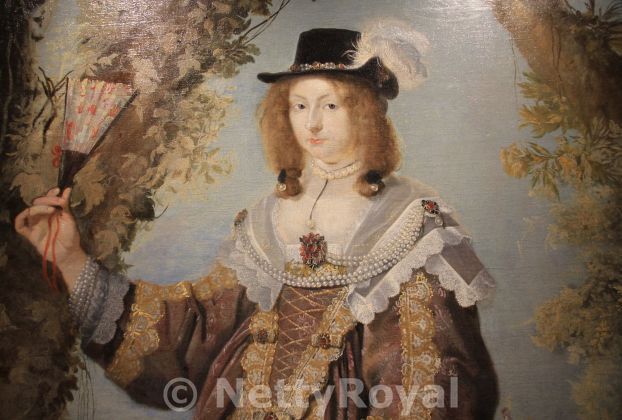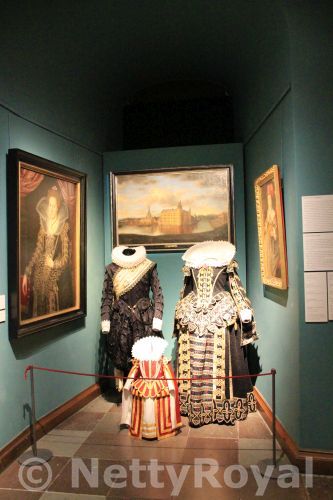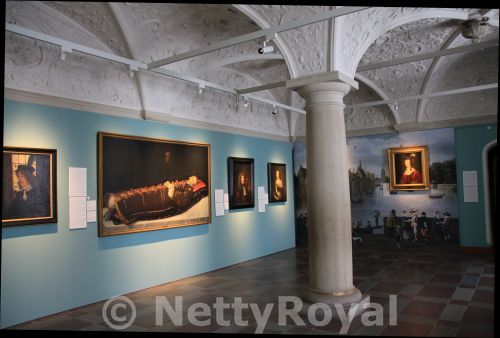Exhibition
Until 7 August 2022 a small but interesting exhibition can be visited at Frederiksborg Castle about a Danish king’s daughter: “Leonora Christina 400 years – a voice of Danish history”. You can find it near the castle shop on the ground floor. Most portraits painted during her lifetime are in the possession of the museum, as well as artefacts, that are exhibited right now. The paintings show her often with a black-velvet hat, and she once explained herself that, although it is unclear whether this is true, the hat was only worn by the daughters of Kings.
Also on display is the original manuscript of her autobiographical work “Jammers Minde”. The exhibition gives people the opportunity to actual meet one of the most prominent female figures in Danish history. By the way also the restaurant of the museum is named after her: Spisestedet Leonora. The museum’s app Smartify gives you the opportunity to listen to a reading from “Jammers Minde”.



Who is Leonora Christina?
She is an ancestor, via her youngest son Count Leo Ulfeldt, of Fürst Hans Adam II of Liechtenstein, the royal houses of Bulgaria, Romania, Austria, Yugoslavia/Serbia, Princess Michael of Kent and many other royals and nobles. In Denmark and abroad she is nowadays known for her posthumously (in 1869) published autobiography “Jammers Minde” (A Memory of Lament/Memoirs of Leonora Christina). Even in the city where I live, Groningen in the Netherlands, there is a Foundation called Leonora Christina, that encourages the publication of special literary translation projects from Scandinavian languages into Dutch. But who was she?
Countess Leonora Christina of Schleswig and Holstein was born at Frederiksborg Castle, Denmark, on 8 July 1621 as one of the at least 12 children of King Christian IV of Denmark and his second, morganatic, wife Kirsten Munk, from an untitled Danish noble family. Although not being royal, the children grew up at the royal palace in Copenhagen. Leonora Christina’s parents divorced in 1630, when her father accused her mother of being unfaithfull, which she denied by the way, but the young girl remained one of her father’s favourites.
While Danish princes and princesses were not allowed to marry Danish citizens, that didn’t count for the children from this morganatic marriage. Christian IV therefore searched for Danish husbands for six of his daughters, to buy the loyalty of promising nobles. Already at the age of 9 Leonora Christina became engaged to Corfitz Ulfeldt, whose father had been a chancellor. They eventually married on 9 October 1636. Her groom was 15 years older than her and was made a count (Reichsgraf) by the Holy Roman Emperor Ferdinand III in 1641. The couple had 15 children between 1637 and 1651, seven of them reaching adulthood.
Her husband gained power in the years after the wedding, and as there was no queen, Leonora Christina was in many ways the first lady of Denmark. She also studied languages, painting and music. She learnt Danish, French, German and Latin, and later on also Italian, Spanish and English. Corfitz Ulfeldt became Steward of the Realm in 1643. When he had to go abroad, Leonora Christina often would accompany him. 1646-1647 they undertook a diplomatic trip to the Netherlands and France, where they even were received at the royal court. The position of the couple was however threatened after her half-brother Frederik III had succeeded to the throne. The King thought that his brothers-in-law Corfitz Ulfeldt and Hannibal Sehested had too much power. Also Leonora Christina found it difficult to give up her leading position.
In 1651 Corfitz went into exile, after he had been accused of taking part in a plot to poision the royal family. His wife followed him to Amsterdam and Stockholm, where they stayed at the court of Queen Kristina. When Kristina abdicated in 1654 they lent her money for her trip. In the years to follow Leonora Christina and her husband for a while lived in Swedish Pomerania. As a result of the peace treaty arrangements after the Denmark-Sweden war, the Ulfeldts restored all their land in Denmark-Norway and were permitted to return to Denmark. The Swedes accused the Ulfeldts of treacherous contact with the King of Denmark and they were placed under house arrest in Malmö. The family however escaped to Copenhagen, where he soon was imprisoned again for 17 months at Hammershus, Bornholm. His wife, who had led his defence in Sweden, joined him. In 1661 they ransomed themselves by forfeiting all of their Danish property and swore a oath of allegiance to Frederik III. They soon left the country. However in 1662 Corfitz Ulfeldt offered the throne of Denmark to the Elector of Brandenburg. Frederik III was furious and the count was sentenced again by the Supreme Court.
1663 Leonora Christina travelled to England to collect money that her husband had once loaned to King Charles II. While negotiations went on the English King had his cousin arrested in Dover and handed over to the Danes, who thought she was as guilty as her husband. Leonora Christina was imprisoned in the Blue Tower of Copenhagen Castle. Her husband escaped and joined his children abroad, however he died in February 1664 on a boat on the Rhine between Basel and Neuenburg am Rhein (Germany) without ever having seen his wife again.
She never was charged or trialed, but remained in prison for 21 years, 9 months and 11 days, although her life was eased a lot after her nephew King Christian V succeeded to the throne. But only after his mother Sophie Amalie, the biggest enemy of the countess, had died in 1685, she was released. She died quietly on 16 March 1698 at Maribo Abbey, Lolland, where she had spent her final years, and was buried in the crypt of the Abbey Church of Maribo (now the cathedral). However her remains were soon removed. She was probably reburied in Vienna, Austria, where her son Leo made a great career, although it remains a mystery where exactly. Her tombstone and the crypt, in which she was buried originally, can still be seen in Maribo. There is also a memorial stone for her.
During her years in prison and in the twelve years afterwards she wrote her book “Jammers Minde”, in which she writes about her years in prison in detail. It wouldn’t make her famous until 1869, when it was published. Nowadays it is regarded as a classic of 17th century Danish literature. Already in the 1650s she had written an account of the wedding of King Karl X Gustav of Sweden in 1654, and wrote about her journey to Korsør to seek reconciliation with King Frederik III in 1656. She also wrote an account about her happy childhood in French, that was smuggled out of prison in 1673. Furthermore she translated tales of women in adversity.
